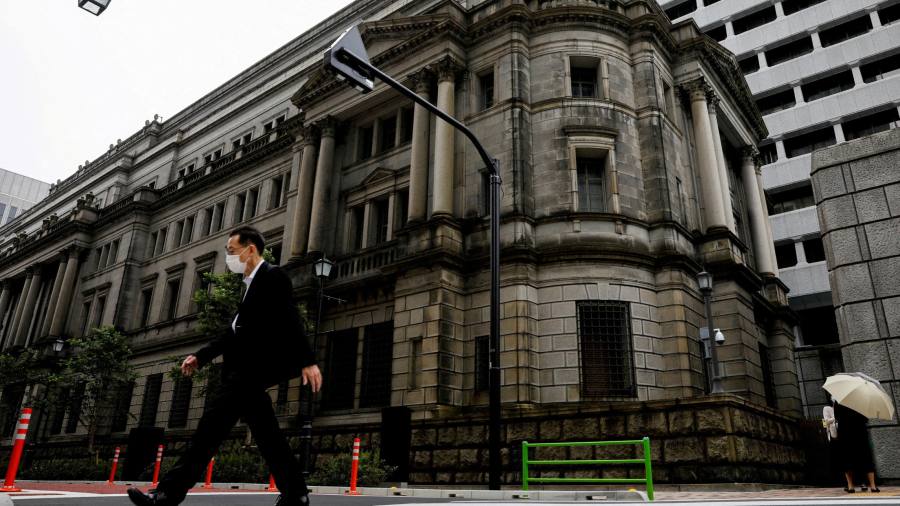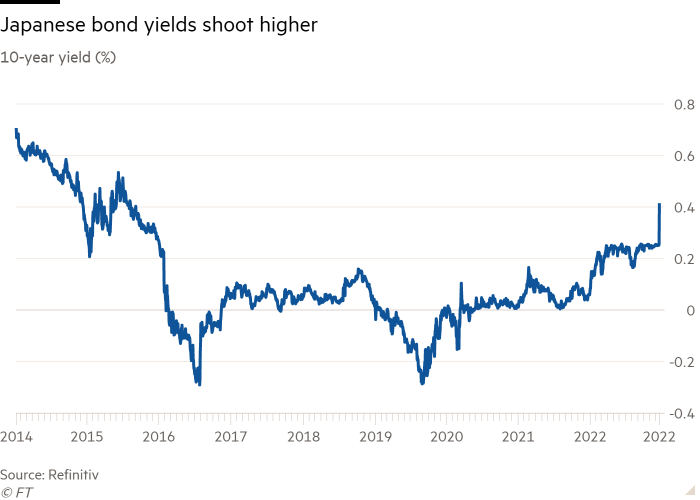Bank of Japan stuns markets with yield control policy change

The Bank of Japan stunned markets on Tuesday with an unexpected change to its controversial yield curve control policy, triggering big swings in the currency, bond and equity markets.
Traders described the move as potentially marking the long-awaited “pivot” by the BoJ, which is the last of the world’s leading central banks to stick to an ultra-loose regime of avoiding raising interest rates to tackle global inflation.
“We view this decision as a major surprise, as we had expected any widening of the tolerable band to be made under the new BoJ leadership from spring next year, similar to the market,” said Naohiko Baba, chief Japan economist at Goldman Sachs.
In a news conference, however, BoJ governor Haruhiko Kuroda denied that the latest adjustment amounted to a tightening of monetary policy, stressing that the central bank would not scrap its yield target.
Japan’s increasingly extreme outlier status has contributed to a huge fall in the yen this year as markets have priced in the differential with the rate-tightening US Federal Reserve.
The central bank said it would allow 10-year bond yields to fluctuate by plus or minus 0.5 per cent, instead of the previous 0.25 per cent. It kept overnight interest rates at minus 0.1 per cent.

Kuroda had earlier said any tweak to the yield curve control (YCC) would effectively amount to an interest rate increase. But on Tuesday, he said the adjustment was meant to address increased volatility in global financial markets and improve bond market functioning to “enhance the sustainability of monetary easing”.
“This measure is not a rate hike,” Kuroda said. “Adjusting the YCC does not signal the end of YCC or an exit strategy.”
Japan’s core inflation — which excludes volatile food prices — has exceeded the BoJ’s 2 per cent target for the seventh consecutive month, hitting a 40-year high of 3.6 per cent in October.
But Kuroda had long argued that any tightening would be premature without robust wage growth, which is why most economists had expected the BoJ to stay the course until he steps down in April. On Tuesday, the BoJ maintained its outlook that inflation would slow down next year and warned of “extremely high uncertainties” for the economy.
“Maybe it’s an act of generosity by Kuroda to reduce the burden for the next BoJ governor, but it’s a dangerous move and market players feel duped,” said Masamichi Adachi, chief Japan economist at UBS. “US yields are falling now but if they start to rise again, the BoJ would once again face the risk of being pressured into raising rates.”
The BoJ’s efforts to defend its YCC targets have contributed to a sustained reduction in market liquidity and what some analysts have described as “dysfunction” in the Japanese government bonds market. The central bank now owns more than half of outstanding bonds, compared with 11.5 per cent when Kuroda became governor in March 2013.

Kyohei Morita, chief Japan economist at Nomura Securities, said the BoJ’s move was probably best seen as a policy tweak rather than a full pivot. “Probably the BoJ wants to contribute to reducing the negative side effects of the yield curve control policy,” he said, noting that the bank’s outsized ownership of the Japanese government bonds market meant that liquidity had evaporated.
“They want to reactivate that market, even at the price of yen appreciation,” said Morita.
The yen briefly jumped almost 3 per cent to about ¥133 against the US dollar, while the Topix equity index fell as much as 2.5 per cent and the yield on the 10-year bond rose to 0.46 per cent, its highest level since 2015. In recent weeks, the Japanese currency has rebounded from a 32-year low as policymakers in the US and Europe have begun to scale back the size of their interest rate increases.
The BoJ’s move on Tuesday also ricocheted across other big markets. The US 10-year Treasury yield rose 0.08 percentage points to 3.66 per cent, while the equivalent UK gilt yield increased by the same margin to 3.58 per cent. Yields rise when prices fall.
Mansoor Mohi-uddin, chief economist at Bank of Singapore, said the BoJ’s move was significant because it signalled the central bank was considering a broader exit from YCC, adding it would be an important turning point for the yen.
“The BoJ decision to raise interest rates in December 1989 led to a major sea change in Japanese markets,” said Mohi-uddin. “Today’s officials will be keenly aware of that history. It amplifies the significance of their signal to the markets today.”
Benjamin Shatil, foreign exchange strategist at JPMorgan, said the BoJ’s move would now lead the market to start pricing in further policy moves, even if none were actually forthcoming.
“That dynamic can launch another cycle of higher Japan yields, testing of the new or higher YCC target ceiling and renewed bouts of yen strength,” said Shatil. “It also has ramifications for global markets, given the potential for continued asset reallocation of Japanese investors from overseas bonds back to domestic bonds — now that they offer a more attractive higher yield.”
Share this news on your Fb,Twitter and Whatsapp
Times News Express:Latest News Headlines
Times News Express||Health||New York||USA News||Technology||World News